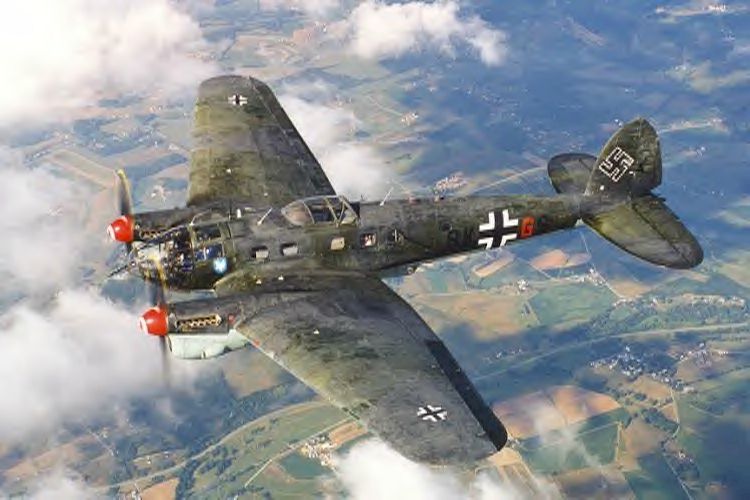|

This CASA 211 was owned and operated by the
Commemorative Air Force, Mesa, Arizona, USA. Photo taken over Frederick, Maryland, USA in
August 2000 by Gregory Witmer, from Larry Kelley's B-25
"Panchito." This aircraft was lost in an accident in July 2003.
History: When World War I ended, the German
Air Force was disbanded under the Treaty of Versailles, which required the German
government to abandon all military aviation by October 1, 1919. However, by 1922, it was
legal for Germany to design and manufacture commercial aircraft, and one of the first
modern medium bombers to emerge from this process was the Heinkel He 111,
the first prototype of which an enlarged, twin-engine version of the single-engine
mail-liaison He 70, which set 8 world speed records in 1933 flew in February of 1935. The
second prototype, the He 111 V2, had shorter wings and was the
first civil transport prototype, capable of carrying 10 passengers and mail. The third
prototype, He 111 V3 also had shorter wings and was the first
true bomber prototype. Six He 111 C series airliners were
derived from the fourth prototype, the He 111 V4, and went into
service with Lufthansa in 1936, powered by a variety of engines, including BMW 132
radials. The first production models had the classic stepped windshield and an elliptical
wing, which the designers, Siegfried and Walter Gunter, favored.
As a military aircraft, it took longer to gain favor, because military load
requirements and underpowered engines kept its cruising speed down to less than 170 mph.
However, in early 1936, the plane was given 1,000 hp Daimler Benz DB 600A engines which
improved performance dramatically enough to bring in substantial orders. The first two
mass-production versions, He 111 E and He 111 F
experienced great success during the Spanish Civil War, where they served with the Condor
Legion as fast bombers, able to outrun many of the fighters sent against them.
In fact, the experience in Spain generated a false sense of security in which the
Germans thought that the He 111's light armament and speed would be sufficient in the
coming war. Thus, although it was out of date, the large numbers in which it had been
produced made the He 111 the Luftwaffe's primary bomber for far too long in the war,
availability being more persuasive than practicality for this serviceable, but highly
vulnerable, aircraft. Modern fighters like the Supermarine Spitfire and the Hawker
Hurricane proved the He 111's inadequacy during the Battle of Britain. As soon as
possible, the Luftwaffe replaced the Heinkel with the Junkers Ju 88, reassigning the
Heinkel to night operations and other specialized tasks until, by war's end, it was being
used primarily as a transport.
More than 7,300 had been built for the Luftwaffe by autumn, 1944, with another 236
(He 111H) being built by the Spanish manufacturer, CASA, during
and after the war (as the CASA 2.111), some with the traditional
Jumo 211 engines, some with Rolls-Royce Merlins. In service with the Luftwaffe from 1937
to 1945, the Heinkels remained in Spanish service until 1965.
One of the more bizarre adaptations of the Heinkel by the Luftwaffe was the He
111 Z-1, in which two He 111s were joined at the wing with a special section
containing a fifth engine. Two prototypes and 10 production models were manufactured,
their purpose being to provide the power to haul the huge Messerschmitt Me 321 transport
gliders.
The sole remaining He 111 in regular use was owned by the Arizona wing of the
Commemorative Air Force in the USA. It was a Spanish-built CASA 2.111D that was used to
transport VIPs during the Franco regime. Unfortunately, it was destroyed in a crash in
July 2003. Another He 111 is currently under restoration in the USA.
Nicknames: Pedro (Condor Legion
nickname).
Specifications (He 111H-16):
Engines: Two 1,350-hp Jumo 211F-2 inverted V-12 piston engines
Weight: Empty 19,136 lbs., Max
Takeoff 30,865 lbs.
Wing Span: 74ft. 1.75in.
Length: 53ft. 9.5in.
Height: 13ft. 1.25in.
Performance:
Maximum Speed at
Sea Level: 227 mph
Ceiling: 21,980
ft.
Range: 1,212
miles
Armament:
One 20-mm MG FF
cannon;
One 13-mm
(0.51-inch) MG 131 machine gun;
Three 7.92-mm
(0.31-inch) MG 81Z machine guns;
Internal
bomb-load of 2,205 pounds.
Number Built: 7,300+
Number Still Airworthy:
None, but one is
currently under restoration.
Links:
Battle of Britain Historical
Society: He 111 History Page
Canadian Aces He 111 Page
C.J. Chapman's report:
He 111 visits Kingston, Ontario, Canada
Hope Pilots Association: "He 111 --
Gone, But Not Forgotten"
It's Russian
Richard
Seaman's He 111 Photos
Warbirds Resource
Group: He 111 Page
WWII Relics Site: He 111 Page

[Back to Warbird Alley's Main
Page]
All text and photos Copyright 2016 The
Doublestar Group, unless otherwise noted.
You may use this page for your own, non-commercial reference purposes only.
 |